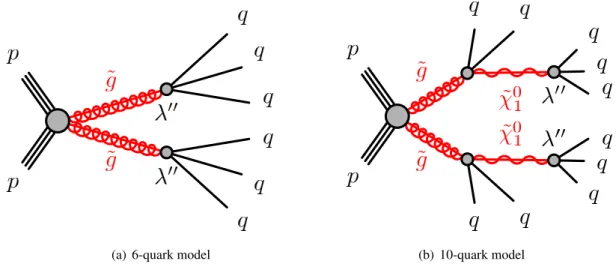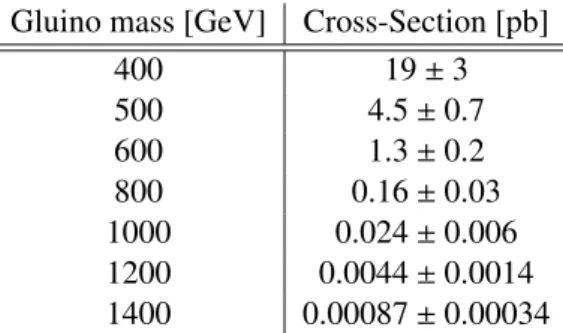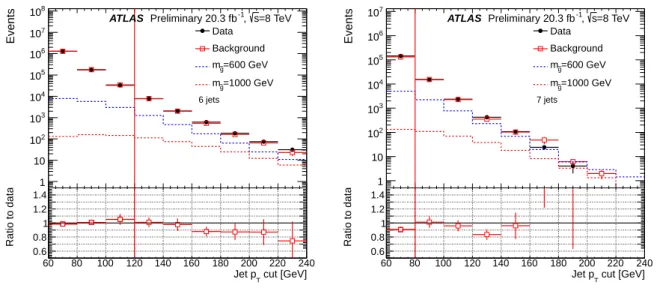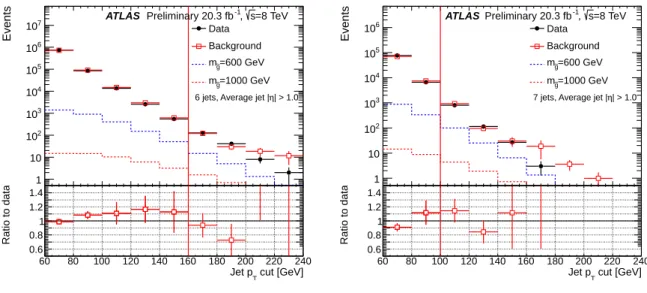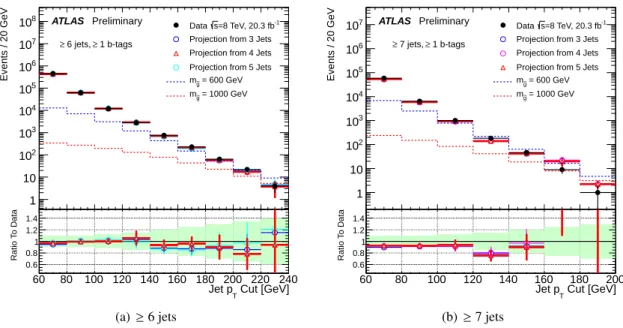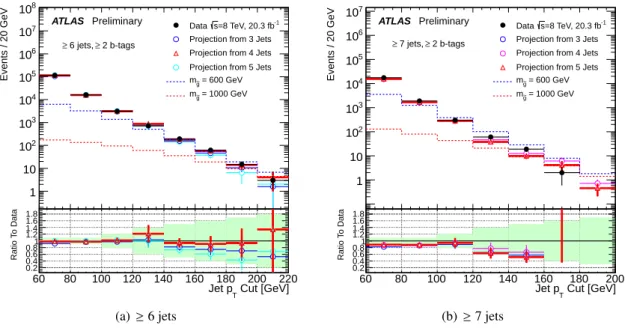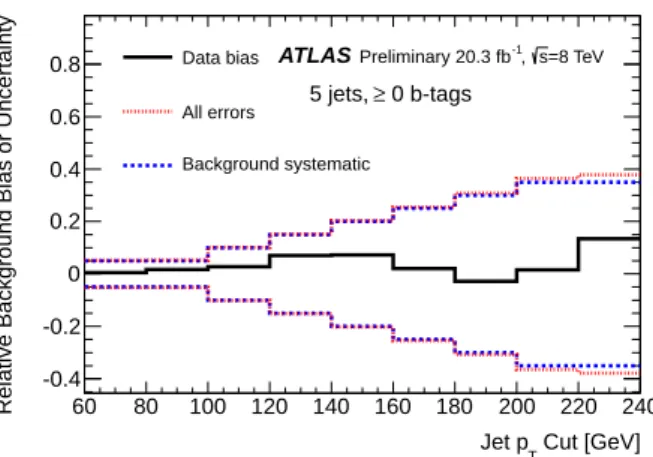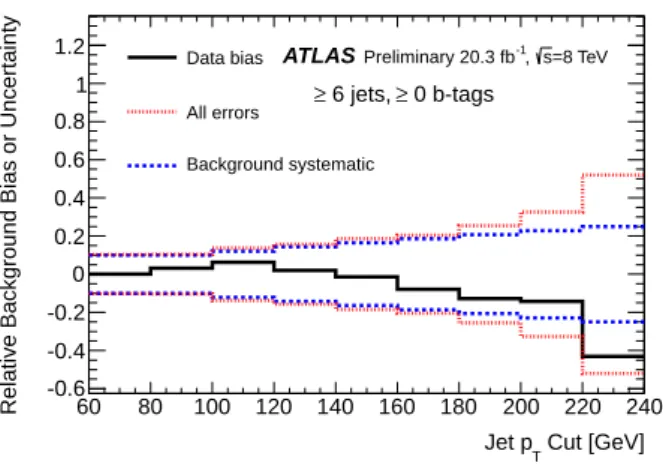A TLAS-CONF-2013-091 28 August 2013
ATLAS NOTE
ATLAS-CONF-2013-091
August 26, 2013
Search for massive particles decaying into multiple quarks with the ATLAS detector in √
s = 8 TeV pp collisions
The ATLAS Collaboration
Abstract
A search is conducted for hadronic decays of new massive particles in √
s = 8 TeV pp collisions using an integrated luminosity of 20.3 fb
−1collected by the ATLAS detector at the LHC. Gluino production in the context of supersymmetry models in which R-parity is not conserved is used as a benchmark scenario, both for the case where the gluino is the lightest supersymmetric partner, and for the case where it decays to a neutralino which then undergoes an R-parity violating decay. A selection on the number of jets, their trans- verse momenta, and the number of jets identified as originating from a b-quark is applied and a counting experiment is performed. Results are presented for all possible R-parity vi- olating branching fractions of gluino decays to various quark flavours. In a model where pair-produced gluinos each decay into three light-flavour quarks, exclusions of m
g˜< 853 GeV (expected) and m
g˜< 917 GeV (observed) are placed at the 95% confidence level.
Alternately, for a model where each gluino decays into one b-jet and two light quarks, ex- clusions of m
g˜< 921 GeV (expected) and m
g˜< 929 GeV (observed) are set. Limits are also set for decay modes to a variety of other flavours as well as for decay modes through an intermediary neutralino, which leads to 10-quark final states.
⃝ c Copyright 2013 CERN for the benefit of the ATLAS Collaboration.
Reproduction of this article or parts of it is allowed as specified in the CC-BY-3.0 license.
1 Introduction
The analysis presented here is designed as a search for new physics in various final states with a large number of high transverse momentum ( p
T) jets. Results are interpreted in the context of two R-parity violating (RPV) supersymmetric models. In one model, which is referred to as the “6-quark model”, gluinos are pair-produced and decay promptly via a virtual (mass of 5 TeV) squark in the cascade decay ( ˜ g → qq ˜ → qqq ). In the second model, referred to as the “10-quark model”, gluinos are pair-produced and decay via an intermediate on-shell neutralino in the process ( ˜ g → q q ˜ → qq χ ˜
01→ qqqqq). The diagrams corresponding to these processes are shown in Fig. 1. This is the first ever search for the 10- quark signature. Exclusion limits in the 6-quark model have been placed by the CDF collaboration with m
g˜< 144 GeV [1], the CMS collaboration with m
g˜< 460 GeV using 5 fb
−1of √
s = 7 TeV data [2], and the ATLAS collaboration with m
g˜< 666 GeV using 4.6 fb
−1of data at √
s = 7 TeV [3].
This analysis updates the ATLAS RPV multi-jet search of Ref. [3] to the full 2012 √
s = 8 TeV dataset. In addition, two new results are added. Firstly, the 10-quark model is included. Secondly, b-tagging information is used to make new interpretations in the space of RPV coupling parameters.
For this analysis the Minimal Supersymmetric Standard Model (MSSM) of SUSY with R-Parity con- servation [4–17] is used but with an additional component added to the Lagrangian that allows RPV interactions. The extra terms of the Lagrangian correspond to the additional superpotential [18, 19]
W
̸Rp= 1
2 λ
i jkL
iL
jE ¯
k+ λ
′i jkL
iQ
jD ¯
k+ 1
2 λ
′′i jkU ¯
iD ¯
jD ¯
k+ κ
iL
iH
2, (1) where i, j , k = 1, 2, 3 are generation indices. The subject of this analysis is the third term of this equation,
1
2
λ
′′i jkU ¯
iD ¯
jD ¯
k. It is this term that allows the gluino to decay into three quark jets in the 6-quark model. In the 10-quark model, on the other hand, it is the second decay, ˜ χ
01→ qqq that proceeds via this term. The RPV Lagrangian term ensures that each decay under this coupling produces exactly one up-type quark and two down type quarks (of di ff erent flavours). The flavours of the decay products depend entirely on the values of the λ
′′i jkfactors, which can only be constrained by the data as they are not predicted by the model.
It is assumed that the λ
′′i jkterms lead to short enough lifetimes for the ˜ g and for the ˜ χ
01that the dis- placements of the RPV decays from the primary vertex are negligible, and it is further assumed that the gluino width is small compared to the detector resolution. These assumptions are in common with pre- vious RPV multijet analyses. Unlike previous RPV multi-jet analyses, flavour information is used here.
The limits that have been previously set were based upon the assumption of a 100% decay branching fraction of gluinos into three quarks and assumed that the processes would be identical for each flavour.
Some RPV terms in Eq. 1, however, lead to top quarks in the RPV decay products, which were assumed to not be present in previous searches. Other RPV terms lead to charm and bottom quarks. Dedicated selections which use b-tagging information are employed to target signatures with top, bottom and charm quarks, allowing conclusions to be drawn for various flavour RPV decays (as driven by the λ
′′i jkfactors).
Limits are set based upon the branching fractions of RPV decays into each given quark flavour. This analysis searches for an excess of multi-jet events by counting the number of high transverse momentum (at least 80 GeV) 6-jet and 7-jet events, with various b-tagging requirements added to enhance the sen- sitivity to couplings that favour decays to third generation quarks. The number of jets, the p
Tcut that is used to select jets, and the number of b-tags are optimised separately for each signal model taking into account experimental and theoretical uncertainties.
The outline of this document is as follows. Section 2 describes the ATLAS detector and the technical
reconstruction of collision events at ATLAS. Section 3 describes the data samples used in the analy-
sis. Section 4 discusses the background determination, and provides a number of data-driven studies to
validate and estimate uncertainties on the background models. Section 5 discusses the systematic un-
(a) 6-quark model (b) 10-quark model
Figure 1: Feynman diagrams for the gluino decays used as benchmarks for this search. Diagrams for (a) the 6-quark model and (b) the 10-quark model are shown.
Section 6.
2 Detector, data acquisition, and object definitions
The ATLAS detector [20, 21] provides nearly full solid angle coverage around the collision point with an inner tracking system covering |η| < 2.5
1, electromagnetic and hadronic calorimeters covering |η| < 4.9, and a muon spectrometer covering |η| < 2 . 7.
The ATLAS tracking system is comprised of a silicon pixel tracker closest to the beamline, a mi- crostrip silicon tracker, and a straw-tube transition radiation tracker at radii up to 108 cm. These systems are layered radially around each other in the central region. A thin solenoid surrounding the tracker provides an axial 2 T field enabling measurement of charged particle momenta. The track reconstruction efficiency ranges from 78% at p
trackT= 500 MeV to more than 85% above 10 GeV, with a transverse impact parameter resolution of 10 µ m for high momentum particles in the central region. The overall acceptance of the inner detector (ID) spans the full range in ϕ , and the pseudorapidity range |η| < 2 . 5 for particles originating near the nominal LHC interaction region.
The calorimeter comprises multiple subdetectors with several di ff erent designs, spanning the pseu- dorapidity range up to |η| = 4 . 9. The measurements presented here use data from the central calorimeters that consist of the Liquid Argon (LAr) barrel electromagnetic calorimeter (|η| < 1.475) and the Tile hadronic calorimeter (|η| < 1.7), as well as two additional calorimeter subsystems that are located in the forward regions of the detector: the LAr electromagnetic end-cap calorimeters (1 . 375 < |η| < 3 . 2), and the LAr hadronic end-cap calorimeter (1.5 < |η| < 3.2). As described below, jets are required to have
|η| < 2.8 such that they are fully contained within the barrel and end-cap calorimeter systems.
The jets used for this analysis are found and reconstructed using the anti-k
talgorithm [22, 23] with a radius parameter R = 0 . 4. The energy of the jet is corrected for inhomogeneities and for the non- compensating nature of the calorimeter by weighting the energy deposits in the electromagnetic and the hadronic calorimeters separately by factors derived from the simulation and validated with the data [24].
1
The ATLAS reference system is a Cartesian right-handed coordinate system, with the nominal collision point at the origin.
The anticlockwise beam direction defines the positive
z-axis, while the positivex-axis is defined as pointing from the collisionpoint to the centre of the LHC ring and the positive
y-axis points upwards. The azimuthal angleϕis measured around the beam
axis, and the polar angle
θis measured with respect to the
z-axis. Pseudorapidity is defined asη=ln[tan(
θ2)], rapidity is defined
as
y=0
.5 ln[(E
+pz)
/(E p
z)], where
Eis the energy and
pzis the
z-component of the momentum, and transverse energy isdefined as
ET=Esin
θ.The jets are further corrected to remove the energy deposits from secondary collisions in the event and from the collisions of other partons within the same protons [25]. In some signal regions either one or two jets are also required to be identified as originating from b-quarks (“b-tagged”). b-tagging at ATLAS uses multivariate algorithms that identify b-hadrons based upon the displacement of individual tracks and upon the displacement, mass, and fragmentation properties of any secondary vertices that are reconstructed within the jet [26]. For this search a tagger was used with an operating setting at a tagging efficiency of roughly 70% for real b-jets in t t ¯ events. Due to the limited geometrical acceptance of the ID, b-tagging is only considered for jets with |η| < 2 . 5.
Trigger decisions at ATLAS are made in three stages: Level 1, Level 2, and the Event Filter. The Level-1 trigger is implemented in hardware and uses a subset of detector information to reduce the event rate to a design value of at most 75 kHz. This is followed by two software-based triggers, Level-2 and the Event Filter, which together reduce the event rate to a few hundred Hz. The measurement presented in this note uses multi-jet triggers which, for the analysis selections used, are more than 99% efficient. The multi-jet triggers implemented at the Event Filter Level have access to the full detector granularity, which allows selection of multi-jet events with high e ffi ciency. Di ff erent triggers are used depending on whether the event will be included in a signal region of the analysis or a control region. The trigger for events that are selected for the signal regions requires six jets with at least 45 GeV of transverse momentum.
When selecting events in data with fewer than six jets for background studies, prescaled triggers were chosen. These prescales were compensated for by weighting events based upon the prescale setting that was active at the time of the collision. For all signal regions in this analysis, however, the jets have a high enough p
Tfor each trigger to be fully e ffi cient.
The data used in this analysis represents 20.3 ± 0.6 fb
−1of integrated luminosity, corresponding to the entire 2012 ATLAS data-taking period [27]. All collision events are required to have met baseline data quality criteria.
3 Simulated events
Simulated samples of pair-produced gluinos are used to estimate the expected signal yield. Several signal models consisting of various mass spectra and decay topologies are considered. The gluino pair- production cross-sections are determined at next-to-leading order in the strong coupling constant, adding the resummation of soft gluon emission at next-to-leading-logarithmic accuracy (NLO + NLL) [28–32].
The total cross-sections and uncertainties for each gluino mass that is considered in this analysis are summarized in Table 1.
Gluino mass [GeV] Cross-Section [pb]
400 19 ± 3
500 4 . 5 ± 0 . 7
600 1.3 ± 0.2
800 0 . 16 ± 0 . 03 1000 0 . 024 ± 0 . 006
1200 0.0044 ± 0.0014
1400 0 . 00087 ± 0 . 00034
Table 1: The signal cross-sections for pp → g˜ ˜ g production depending on gluino mass. The cross- sections are determined with associated theoretical uncertainties at NLO with next-to-leading-logarithm soft gluon resummation (NLO + NLL) (see Section 5.2 for more details).
For gluino pair simulations of the 6-quark and 10-quark models, Herwig++ 6.520 [33] interfaced
showering, hadronization, and underlying event. For the 10-quark model, each produced gluino is forced to decay to two quarks and a neutralino through standard R-parity conserving (RPC) couplings. The neutralinos then undergo the λ
′′i jkdecay to three quarks. The neutralino is considered the lightest su- persymmetric particle here and is, therefore, considered to be on-shell. Samples are produced covering the m
g˜vs m
χ˜01
space with gluino mass points of 400, 600, 800, 1000, 1200, and 1400 GeV. For each gluino mass, separate samples are generated with neutralino masses of 50, 300, and 600 GeV where the latter is only produced for gluino masses of at least 1 TeV. For each point in m
g˜vs m
χ˜01
space, 30000 events are generated using H erwig++ . For the 6-quark gluino model events are produced for each of the following mass points: 500, 600, 800, 1000, and 1200 GeV. In the generation of the samples, all possible λ
′′i jkflavour decay modes are allowed to proceed with equal probability. Results for models with alternate decay modes (resulting from models with alternate λ
′′i jkvalues) are determined by weighting events based upon the flavor of their simulated decay modes. All samples are produced assuming that the gluino width is narrow.
The largest background for this analysis is from multi-jet production. This contribution is estimated from the data aided by dijet events simulated with P ythia 6.426 [35] where two partons are produced in a hard-scatter and a multi-jet final state is produced with a parton shower model. This simulation is discussed in more detail when describing its use in Section 4.2. Other backgrounds are small, however after b-tagging they are not negligible. The second largest background is from t¯ t production in the fully hadronic decay channel. These events are modeled using MC@NLO 4.06 [36] interfaced to Herwig 6.520 [37] with underlying event modeled using Jimmy [38]. Other significant background processes are t¯ t pairs that decay into one or more leptons, which is modeled using S herpa 1.4.1 [39], and W + jets, which is modeled using the Alpgen 2.14 generator [40] interfaced to Pythia 6.426.
These events are processed in a simulation [41] of the detector using G eant 4 [42]. The e ff ect of multiple pp interactions is taken into account in the simulation, though due to the high-p
Trequirements that are placed on the jets, it does not impact the analysis significantly.
4 Background Predictions
4.1 Introduction to the background estimation
The background yield in each signal region is estimated by starting with a signal-depleted control region in data and projecting it into the signal region using a factor that is determined from a multi-jet simulation, with corrections applied to account for additional minor background processes. Rather than treating systematic uncertainties on the background estimation separately, as commonly done, such uncertainties are not divided into categories such as jet energy uncertainties, showering uncertainties, etc. Instead, a single systematic uncertainty on the background yield is determined by comparing the background prediction to the data in a wide variety of control regions. The spread in predictions from many control regions defines the total background uncertainty in the signal region.
4.2 Simulated samples for the background projection
For the multi-jet simulation that is used to make projections from background control regions into the
signal region, one challenge is that a large number of events are required at both very high jet p
Tand
multiplicity (for the signal regions) and at low jet p
Tand low multiplicity (for the control regions). Fur-
ther, one of the requirements of the data-driven error estimation procedure (discussed in Sections 4.4
and 4.5) is that the simulated projection factors must evolve in a consistent way between low and high
jet multiplicity regions. Generators such as Pythia are well-suited to these requirements as they can gen-
erate events very quickly (allowing the production of su ffi ciently large datasets) and have no transition
in behaviour with growing parton multiplicities. This is not the case for multileg matrix elements gen- erators when considering parton multiplicities above that of the hard interaction and jets from the parton shower enter the selection. Such a transition between models of jet production has the potential to cause discontinuities in the multijet spectra important to this analysis. The ATLAS tune AUET2B LO** [43]
of P ythia 6.426 was observed to reproduce the data well in the 7 TeV analysis, and was therefore chosen again for this 8 TeV analysis.
The P ythia multi-jet background events are generated in separate samples filtered by leading jet p
Tin order to ensure that enough events are available in all relevant kinematic ranges, using roughly 45 million events. Since it is slow to simulate the detector e ff ects, these samples are used at particle level and a Gaussian smearing is applied in order to account for jet energy resolution effects [44]. These jets are constructed from interacting final state particles using the same anti-k
talgorithm with a radius parameter of R = 0 . 4 as is used for o ffl ine jets. Muons, neutrinos, and pileup particles are not included in the clustering. Similarly, differences in jet merging or splitting between particle jets and jets reconstructed in the detector are not modeled. The e ff ect of particle-level mismodeling is found to be non negligible but is covered by the total systematic uncertainties evaluated using the data-driven techniques described in Section 5. The b-tagging efficiencies are applied to each simulated jet as a function of the jet flavour,
p
T, and η as determined in dedicated b-tagging calibration measurements [45–48].
4.3 Background projections
The background normalizations are determined by projecting to the signal regions from control regions using projection factors that are derived from the simulation and validated in the data. Validations of these projections are shown in a wide variety of control regions that are used to determine systematic uncertainties on the background estimation in later sections. The formula used for the projections is:
N
ndata−jet= (
N
mdata−jet− N
m−jet,MC OtherBGs)
×
N
n−jetMCN
mMC−jet
+ N
n−jet,MC OtherBGs(2)
In this equation, the number of background events with n jets (N
ndata−jet) is determined starting from the number of events in the data with m jets (N
mdata−jet). The projection factor,
Nn−jetMC
NmMC−jet
, is determined from the multi-jet simulation. Other minor corrections from other backgrounds (“OtherBGs”: t t, single top, ¯ and W + jet events) are also applied based upon estimates from the simulation. Without b-tagging, the contribution of events from OtherBGs is around 1%. Including two b-tags increases this contribution to roughly 10%.
When the projection is performed with n chosen to be five or less, the background is much larger
than the expected signal contribution. Such projections are used to validate the background model for the
purpose of assigning systematic uncertainties. When n is larger than five the expected signal contribution
can become significant for some models. These selection requirements are considered as candidate
signal regions. An optimization is performed to choose the actual signal region used for a given model
and is discussed in Section 6.1. Although other choices are also studied to determine background yield
systematic uncertainties from the data, the backgrounds in the final signal regions are evaluated using
projections across two jet multiplicity bins (n = m + 2). This choice was verified to lead to small signal
contamination in the control regions.
4.4 Background projection validation and systematic uncertainties from lower jet mul- tiplicity data
Since the 3, 4, and 5-jet multiplicity bins have minimal expected signal contamination they are useful for validating the background model. The basic validation of the background prediction is performed by projecting the background from the m = 3 or m = 4 jets into the n = 5 jets control region and comparing with the data. This comparison is shown in Fig. 2, which shows the number of events passing a given jet p
Tcut with a 5 jet requirement. It is seen that the projection has a good accuracy in the extrapolations to the 5-jet bin in data, both with and without the requirement of b-tagging. The conclusion of this validation study is that Eq. 2 can be used with no correction factors, but a systematic uncertainty on the method should be applied to account for the discrepancies between data and the prediction in the validation regions. This systematic is required to cover the largest discrepancy that is observed between data and the prediction when projecting from either the 3-jet or 4-jet bins into the 5-jet control region, as well as from projections to higher jet multiplicity to be discussed shortly.
4.5 Background validation cross-checks and systematic uncertainties
In Section 4.4 it was shown that the projection factor is accurate when projecting into the five jet bin from lower jet multiplicity bins. It is important to also verify that such projection factors are still correct at higher jet multiplicities. As a first cross-check a projection is performed into the six and seven exclusive jet bins but with a low enough jet p
Trequirement to serve as a background control region. Any jet mul- tiplicity bins with a signal contribution of more than 10% for the 600 GeV 6-quark model were not used as control regions, and were excluded from the evaluation of the background systematic uncertainties.
Results of these projections are shown in Fig. 3.
For the signal region, selection requirements are made on jet p
T, jet multiplicity, and number of b-tags. Several other variables were considered, however the tight p
Tand multiplicity requirements in the signal region strongly a ff ect the event kinematics making the gains from additional kinematic re- quirements small enough that the benefits do not justify the added complexity. With looser selection requirements, however, additional kinematic variables can be used to reduce the signal contribution fur- ther and create background-enriched control regions. Among the many kinematic distributions that have been considered, one that appears to show both good discrimination between signal and Standard Model- dominated data samples, and which is well modeled by the simulation, is the average |η| of the selected jets. These kinematic shapes are shown for two di ff erent sets of selection requirements in Fig. 4. The jets from these centrally produced pairs of gluinos typically have lower values in this distribution than the uncorrelated production of jets in the background. A requirement of average jet |η| > 1 . 0 is applied to deplete the expected signal contamination for certain background studies. This choice was determined to be the tightest cut that can reasonably be performed without unacceptably depleting the sample statis- tics. Under this requirement, bins at higher jet p
Thad a low enough expected signal contamination to be considered for the evaluation of the systematic uncertainty. Results of these projections are shown for the 6-jet and 7-jet bins in Fig. 5. The largest deviations from the expected values were found to be a few percent larger than they were for the 5-jet projections.
For a given jet p
Tand tagging requirement, the final systematic uncertainties on the background are
chosen to cover the worst observed discrepancies of all projections considered so far. Specifically, the
uncertainties must be larger than the largest systematic bias observed in Fig. 2. Additionally, if any of the
projections into the lower jet p
Tcontrol regions of Figs. 3 or 5 that could be observed leads to a larger
discrepancy, the background systematic uncertainty is increased to cover this difference.
60 80 100 120 140 160 180 200 220 240
Events / 20 GeV
103
104
105
106
107
108
109
1010
=8 TeV, 20.3 fb-1 s
Data
Projection from 3 Jets Projection from 4 Jets
= 600 GeV g~ m
= 1000 GeV g~ m ATLAS Preliminary
0 b-tags
≥ 5 jets,
Cut [GeV]
Jet pT
60 80 100 120 140 160 180 200 220 240
Ratio To Data
0.6 0.8 1 1.2 1.4
(a)
≥0
b-tags required60 80 100 120 140 160 180 200 220 240
Events / 20 GeV
102
103
104
105
106
107
108
109 -1
=8 TeV, 20.3 fb s
Data
Projection from 3 Jets Projection from 4 Jets
= 600 GeV g~ m
= 1000 GeV g~ m ATLAS Preliminary
1 b-tags
≥ 5 jets,
Cut [GeV]
Jet pT
60 80 100 120 140 160 180 200 220 240
Ratio To Data
0.6 0.8 1 1.2 1.4
(b)
≥1
b-tags required60 80 100 120 140 160 180 200 220 240
Events / 20 GeV
10 102
103
104
105
106
107
108 Data s=8 TeV, 20.3 fb-1
Projection from 3 Jets Projection from 4 Jets
= 600 GeV g~ m
= 1000 GeV g~ m ATLAS Preliminary
2 b-tags
≥ 5 jets,
Cut [GeV]
Jet pT
60 80 100 120 140 160 180 200 220 240
Ratio To Data
0.20.4 0.60.81 1.21.4 1.61.8
(c)
≥2
b-tags requiredFigure 2: The number of observed events in the 5-jet bin is compared to the background expectation that is determined by using P ythia to project the number events in data from the low-jet multiplicity control regions. The contents of the bins represent the number of events with 5-jets passing a given jet p
Tcut.
These bins are inclusive in jet p
T. Results with various b-tag requirements are shown.
60 80 100 120 140 160 180 200 220 240
Events
1 10 102
103
104
105
106
107
108
Data Background
=600 GeV
g~
m
=1000 GeV
g~
m 6 jets
ATLAS Preliminary 20.3 fb-1, s=8 TeV
cut [GeV]
Jet pT
60 80 100 120 140 160 180 200 220 240
Ratio to data
0.6 0.8 1 1.2 1.4
(a) Projection from the 4-jet to the 6-jet bin
60 80 100 120 140 160 180 200 220 240
Events
1 10 102
103
104
105
106
107
Data Background
=600 GeV
g~
m
=1000 GeV
g~
m 7 jets
ATLAS Preliminary 20.3 fb-1, s=8 TeV
cut [GeV]
Jet pT
60 80 100 120 140 160 180 200 220 240
Ratio to data
0.6 0.8 1 1.2 1.4
(b) Projection from the 5-jet to the 7-jet bin
Figure 3: The data are compared with the expected background shapes in the exclusive six and seven jet bins before b-tagging. The contents of the bins represent the number of events with the given number of jets passing a given jet p
Trequirement. The bins with less than 10% signal contamination are control regions that are considered when assigning systematic uncertainties on the background yield. These control regions are the bins to the left of the vertical red lines in the plots.
η| Average jet |
0 0.5 1 1.5 2 2.5
Normalized Distributions
0 0.05 0.1 0.15 0.2
0.25 ATLASPreliminary, 20.3 fb-1, s = 8 TeV Data
=600 GeV
~g
m
=1000 GeV
~g
m
160 GeV
T≥ 3 jets, p
(a) Average jet
|η|, 3 jets withpT >160 GeV
η| Average jet |
0 0.5 1 1.5 2 2.5
Normalized Distributions
0 0.05 0.1 0.15 0.2 0.25
0.3 ATLASPreliminary, 20.3 fb-1, s = 8 TeV Data
=600 GeV
g~
m
=1000 GeV
g~
m
160 GeV
T≥ 5 jets, p
(b) Average jet
|η|, 5 jets withpT>160 GeV
Figure 4: Normalized distributions of average jet |η| of the jets above the given p
Tthreshold are shown
for the Standard Model-dominated data sample and for two signal models before b-tagging.
60 80 100 120 140 160 180 200 220 240
Events
1 10 102
103
104
105
106
107 Data
Background
=600 GeV
g~
m
=1000 GeV
g~
m
| > 1.0 η 6 jets, Average jet | ATLAS Preliminary 20.3 fb-1, s=8 TeV
cut [GeV]
Jet pT
60 80 100 120 140 160 180 200 220 240
Ratio to data
0.6 0.8 1 1.2 1.4
(a) Projection from the 4-jet to the 6-jet bin. Average
|η|>1.0.
60 80 100 120 140 160 180 200 220 240
Events
1 10 102
103
104
105
106 Data
Background
=600 GeV
g~
m
=1000 GeV
g~
m
| > 1.0 η 7 jets, Average jet | ATLASPreliminary 20.3 fb-1, s=8 TeV
cut [GeV]
Jet pT
60 80 100 120 140 160 180 200 220 240
Ratio to data
0.6 0.8 1 1.2 1.4
(b) Projection from the 5-jet to the 7-jet bin. Average
|η|>1.0.
Figure 5: The data are compared with the expected background shapes in the exclusive six and seven jet bins before b-tagging, and with an additional requirement of the average jet pseudorapidity |η| > 1.
The bins with less than 10% signal contamination are control regions that are considered when assigning systematic uncertainties on the background yield. These control regions are the bins to the left of the vertical red lines in the plots.
4.6 Data in the candidate signal regions
Distributions for data in the ≥ 6- and ≥ 7-jet bins are shown in Fig. 6, compared with background predictions that are determined when projecting from three different jet multiplicity bins. In each case the red distribution represents the actual background prediction that will be considered in this analysis while the other projections are simply considered as additional validation. Similarly, results after b-tagging are shown in Figs. 7 and 8. The background systematic uncertainties that were determined from the validations in data are shown as the green band in the bottom of each plot. The bins in these distributions represent candidate signal regions, which may be chosen as a real signal region for a particular model under the optimization procedure that is described in Section 6.1 except for regions deemed insensitive to the model and used as a control region in the systematic uncertainty determination. In practice it is seen that for most signals, the seven jet bin is preferred as a signal region. The data in each distribution show good agreement with background predictions within uncertainties.
5 Systematic Uncertainties
Systematic uncertainties on the background estimation are determined directly from the data as part of the background validation discussed in Section 4.5 and further discussed in Section 5.1. In contrast, sys- tematic uncertainties on the signal predictions are drawn from several sources of modeling uncertainties.
The largest systematic uncertainties are those on the background yield and the jet energy scale uncer-
tainties on the signal yield. These and all other significant uncertainties are explained in the following
sections.
60 80 100 120 140 160 180 200 220 240
Events / 20 GeV
10 102
103
104
105
106
107
108
109
=8 TeV, 20.3 fb-1
s Data
Projection from 3 Jets Projection from 4 Jets Projection from 5 Jets
= 600 GeV
g~
m
= 1000 GeV
g~
m ATLAS Preliminary
0 b-tags
≥ 6 jets,
≥
Cut [GeV]
Jet pT
60 80 100 120 140 160 180 200 220 240
Ratio To Data
0.60.7 0.8 0.91.11 1.2 1.31.4
(a)
≥6 jets
60 80 100 120 140 160 180 200 220
Events / 20 GeV
1 10 102
103
104
105
106
107
108
=8 TeV, 20.3 fb-1
s Data
Projection from 3 Jets Projection from 4 Jets Projection from 5 Jets
= 600 GeV
g~
m
= 1000 GeV
g~
m ATLAS Preliminary
0 b-tags
≥ 7 jets,
≥
Cut [GeV]
Jet pT
60 80 100 120 140 160 180 200 220
Ratio To Data
0.60.7 0.8 0.91.11 1.2 1.31.4
(b)
≥7 jets
Figure 6: The number of observed events in the ≥ 6- and ≥ 7-jet bin is compared with expectations that are determined by using P ythia to project the number of observed events from low-jet multiplicity control regions. The red-colored distribution, representing the projection across two jet multiplicity bins, is the one that will be considered as the final background prediction in each case, while the other projections are treated as cross-checks. No b-tags are required. The contents of the bins represent the number of events with at least 6 jets passing a given jet p
Trequirement. The data are compared with the background expectations from the projections. In the ratio plots the green bands convey the background systematic uncertainties.
60 80 100 120 140 160 180 200 220 240
Events / 20 GeV
1 10 102
103
104
105
106
107
108 Data s=8 TeV, 20.3 fb-1
Projection from 3 Jets Projection from 4 Jets Projection from 5 Jets
= 600 GeV
g~
m
= 1000 GeV
g~
m ATLAS Preliminary
1 b-tags
≥ 6 jets,
≥
Cut [GeV]
Jet pT
60 80 100 120 140 160 180 200 220 240
Ratio To Data
0.6 0.8 1 1.2 1.4
(a)
≥6 jets
60 80 100 120 140 160 180 200
Events / 20 GeV
1 10 102
103
104
105
106
107 Data s=8 TeV, 20.3 fb-1
Projection from 3 Jets Projection from 4 Jets Projection from 5 Jets
= 600 GeV
g~
m
= 1000 GeV
g~
m ATLAS Preliminary
1 b-tags
≥ 7 jets,
≥
Cut [GeV]
Jet pT
60 80 100 120 140 160 180 200
Ratio To Data
0.6 0.8 1 1.2 1.4
(b)
≥7 jets
Figure 7: As Fig. 6 but with at least one b-tag required.
60 80 100 120 140 160 180 200 220
Events / 20 GeV
1 10 102
103
104
105
106
107
108
=8 TeV, 20.3 fb-1
s Data
Projection from 3 Jets Projection from 4 Jets Projection from 5 Jets
= 600 GeV
g~
m
= 1000 GeV
g~
m ATLAS Preliminary
2 b-tags
≥ 6 jets,
≥
Cut [GeV]
Jet pT
60 80 100 120 140 160 180 200 220
Ratio To Data
0.20.4 0.60.81 1.21.4 1.61.8
(a)
≥6 jets
60 80 100 120 140 160 180 200
Events / 20 GeV
1 10 102
103
104
105
106
107
=8 TeV, 20.3 fb-1
s Data
Projection from 3 Jets Projection from 4 Jets Projection from 5 Jets
= 600 GeV
g~
m
= 1000 GeV
g~
m ATLAS Preliminary
2 b-tags
≥ 7 jets,
≥
Cut [GeV]
Jet pT
60 80 100 120 140 160 180 200
Ratio To Data
0.20.4 0.60.81 1.21.4 1.61.8
(b)
≥7 jets
Figure 8: As Fig. 6 but with at least two b-tags required.
5.1 Background normalization uncertainty
The background yields are calculated from Eq. 2, and validated with systematic uncertainties determined from the data. These systematic uncertainties are determined from Figs. 2, 3, and 5. Overall, the back- ground systematic uncertainties are chosen to bracket the worst-case discrepancies observed from the control-region projections of these studies. As the background estimation is fully validated with uncer- tainties determined from the data, the resulting systematic uncertainties cover all modeling uncertainties on both the multi-jet simulation and the simulation of the other backgrounds. Other modeling uncertain- ties such as jet energy scale uncertainties, parton showering uncertainties, and b-tagging uncertainties, are not explicitly included in the background systematic uncertainties to avoid double counting.
In addition to the systematic uncertainty on the background normalisation, the statistical uncertainties from the data and MC in the control regions must be taken into account when projecting into the signal regions. A visual representation of the size of the background uncertainties compared with observed biases in the data is shown when projecting from the 3-jet bin into the 5-jet bin in Fig. 9. This bias is defined as the relative di ff erence between the observed data and the predicted background ((expectation - data) / expectation)). Since the 5-jet bin was used as one of the inputs to the determination of the background uncertainties, the discrepancy of the data compared to expectations must be smaller than the systematic uncertainties in these plots by construction. Similar plots for projections into the candidate signal regions, where projections are made across two jet bins into the ≥6 and ≥7 jet bins, are shown in Figs. 10 and 11. In these plots the statistical uncertainties become significantly larger, as expected.
An additional systematic uncertainty is assigned to cover possible contamination of signal in the control regions for the projection. The analysis was rerun with signal injected into the control regions in the data and the backgrounds were re-computed. The resulting bias depends on the signal model and is observed to be less than 5% in all cases. This bias is taken as a systematic uncertainty.
5.2 Uncertainties in the signal expectation
Various uncertainties on the signal expectation are considered with a focus on the jet energy scale and jet
energy resolution, flavour tagging uncertainties, and theoretical uncertainties on the signal modeling.
Cut [GeV]
Jet pT
60 80 100 120 140 160 180 200 220 240
Relative Background Bias or Uncertainty
-0.4 -0.2 0 0.2 0.4 0.6
0.8 Data bias
All errors
Background systematic
ATLASPreliminary 20.3 fb-1, s=8 TeV 0 b-tags
≥ 5 jets,
(a)
≥0
b-tag projections from the 3 jet into the 5 jet binCut [GeV]
Jet pT
60 80 100 120 140 160 180 200 220 240
Relative Background Bias or Uncertainty
-0.6 -0.4 -0.2 0 0.2 0.4 0.6 0.8 1 1.2 1.4
Data bias All errors
Background systematic
ATLASPreliminary 20.3 fb-1, s=8 TeV 1 b-tags
≥ 5 jets,
(b)
≥1
b-tag projections from the 3 jet into the 5 jet binCut [GeV]
Jet pT
60 80 100 120 140 160 180 200 220
Relative Background Bias or Uncertainty
-1 -0.5 0 0.5 1 1.5 2 2.5
Data bias All errors
Background systematic
ATLASPreliminary 20.3 fb-1, s=8 TeV 2 b-tags
≥ 5 jets,
(c)
≥2
b-tag projections from the 3 jet into the 5 jet binFigure 9: Comparisons of the bias between data and expectations in the 5-jet control region are shown,
along with a comparison to the main sources of uncertainty. These figures correspond to the projections
of Fig. 2. The solid black line shows the relative di ff erence between the observed data and the predicted
background. The blue distribution shows the relative systematic uncertainty on the background estima-
tion. The red distribution shows the total uncertainty on the comparison between background and data,
including the background systematic uncertainty and all sources of statistical uncertainties including the
statistical uncertainty on the data to which the background is compared.
Cut [GeV]
Jet pT
60 80 100 120 140 160 180 200 220 240 Relative Background Bias or Uncertainty -0.6
-0.4 -0.2 0 0.2 0.4 0.6 0.8 1
1.2 Data bias
All errors
Background systematic
ATLASPreliminary 20.3 fb-1, s=8 TeV 0 b-tags
≥ 6 jets,
≥
(a)
≥0
b-tag projections into the≥6 jet binCut [GeV]
Jet pT
60 80 100 120 140 160 180 200 220 240
Relative Background Bias or Uncertainty
-1 -0.5 0 0.5 1 1.5 2 2.5
Data bias All errors
Background systematic
ATLASPreliminary 20.3 fb-1, s=8 TeV 1 b-tags
≥ 6 jets,
≥
(b)
≥1
b-tag projections into the≥6 jet bin
Cut [GeV]
Jet pT
60 80 100 120 140 160 180 200 220 240
Relative Background Bias or Uncertainty
-1 -0.5 0 0.5 1 1.5 2 2.5 3
Data bias All errors
Background systematic
ATLASPreliminary 20.3 fb-1, s=8 TeV 2 b-tags
≥ 6 jets,
≥
(c)
≥2
b-tag projections into the≥6 jet bin
Figure 10: Similar to Fig. 9, these figures show a comparison of the relative bias between data and
expectations in the ≥ 6-jet region, along with a comparison to the relative systematic uncertainty on the
background and the relative total uncertainty on the comparison between the background and the data.
Cut [GeV]
Jet pT
60 80 100 120 140 160 180 200
Relative Background Bias or Uncertainty
-0.4 -0.2 0 0.2 0.4 0.6 0.8
1 Data bias
All errors
Background systematic
ATLASPreliminary 20.3 fb-1, s=8 TeV 0 b-tags
≥ 7 jets,
≥
(a)
≥0
b-tag projections into the≥7 jet binCut [GeV]
Jet pT
60 80 100 120 140 160 180 200
Relative Background Bias or Uncertainty
-0.6 -0.4 -0.2 0 0.2 0.4 0.6 0.8 1 1.2 1.4
Data bias All errors
Background systematic
ATLASPreliminary 20.3 fb-1, s=8 TeV 1 b-tags
≥ 7 jets,
≥
(b)
≥1
b-tag projections into the≥7 jet bin
Cut [GeV]
Jet pT
60 80 100 120 140 160 180
Relative Background Bias or Uncertainty
-0.5 0 0.5 1
1.5 Data bias
All errors
Background systematic
ATLASPreliminary 20.3 fb-1, s=8 TeV 2 b-tags
≥ 7 jets,
≥
